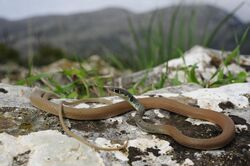Biology:Platyceps najadum
| Platyceps najadum | |
|---|---|

| |
| Scientific classification | |
| Domain: | Eukaryota |
| Kingdom: | Animalia |
| Phylum: | Chordata |
| Class: | Reptilia |
| Order: | Squamata |
| Suborder: | Serpentes |
| Family: | Colubridae |
| Genus: | Platyceps |
| Species: | P. najadum
|
| Binomial name | |
| Platyceps najadum (Eichwald, 1831)
| |
| Synonyms[1] | |
| |
Platyceps najadum, also known commonly as Dahl's whip snake or the slender whip snake, is a species of snake in the family Colubridae. The species is native to Eurasia. Four subspecies are recognized as being valid.
Taxonomy
P. najadum was first described by Karl Eichwald in 1831,[2] as Tyria najadum.[1]
Geographic range
P. najadum is found in the Balkans, Aegean, Cyprus, the Mid-East, and as far as Turkmenistan and the Caucasus Mountains.[3]
Habitat
P. najadum occurs in dry and xeric environments in a wide range of habitats: in desert and rocky land, in forests, woodland scrub, and agricultural land from sea level to 2,000 m (6,600 ft) altitude. It is commonly found in fields, and seen crushed on roads.
Description
P. najadum has a slim body, and is rarely over a metre (39 inches) in total length (including tail).[4]
Conservation status
P. najadum is threatened by direct persecution, forest fires and intensive agriculture, where its range interacts with human interests.[2]
Reproduction
P. najadum is an egg laying species. Females lay between 3 and 16 eggs in a clutch.[2]
Subspecies
Four[1] subspecies are identified, including the nominotypical subspecies.
- Platyceps najadum albitemporalis (Darevsky & Orlov, 1994)
- Platyceps najadum dahlii (Fitzinger, 1826) – Balkans, Cyprus, Aegean Turkey
- Platyceps najadum kalymnensis (B. Schneider, 1979) – endemic to Kalymnos island, the Aegean
- Platyceps najadum najadum (Eichwald, 1831) – Caucasus and Asia Minor
Nota bene: A trinomial authority in parentheses indicates that the subspecies was originally described in a genus other than Platyceps.
Etymology
Both the subspecific name, dahlii, and the common name, Dahl's whip snake, are in honor of Austrian entomologist Georg Dahl (1769–1831) who collected the type specimen in Dalmatia in 1824.[5]
The subspecific name, schmidtleri, is in honor of German herpetologist Josef Friedrich Schmidtler (born 1942).[6]
Indigenous names
Σαϊτα (Greek), Saita, Стрелушка (Bulgarian), šilac (Croatian), Za'aman Z'eitani (Hebrew), Ok Yılanı (Turkish).
References
- ↑ 1.0 1.1 1.2 "Platyceps najadum ". The Reptile Database. http://reptile-database.reptarium.cz/species?genus=Platyceps&species=najadum&search_param=%28%28search%3D%27Platyceps+najadum%27%29%29
- ↑ 2.0 2.1 2.2 Cite error: Invalid
<ref>tag; no text was provided for refs namediucn status 19 November 2021 - ↑ "Platyceps najadum ". French language Wikipédia.
- ↑ "Dahl's Whip Snake (Platyceps najadum) | Archipelago Wildlife Library". http://wildlife-archipelago.gr/wordpress/reptiles/dahls-whip-snake.
- ↑ Biographisches Lexikon des Kaiserthums Oesterreich … volume 3. pages 129-130. 1858.
- ↑ Beolens, Bo; Watkins, Michael; Grayson, Michael (2011). The Eponym Dictionary of Reptiles. Baltimore: Johns Hopkins University Press. xiii + 296 pp. ISBN:978-1-4214-0135-5. (Platyceps najadum dahlii, p. 64; P. n. schmidtleri, p. 236).
Further reading
- Arnold EN, Burton JA (1978). A Field Guide to the Reptiles and Amphibians of Britain and Europe. (Illustrated by D.W. Ovenden). London: Collins. 272 pp. + Plates 1-40. ISBN:0-00-219318-3. (Coluber najadum, pp. 194–195 + Plate 35, figure 4 + Map 106).
- Eichwald [K]E (1831). Zoologia specialis quam expositis animalibus tum vivis, tum fossilibus potissimum Rossiae in universum, et Poloniae in specie, in usum lectionum publicarum, in Universitate Caesarea Vilnensi [Volume 3]. Vilnius: J. Zawadzki. 404 pp. + one plate. (Tyria najadum, new species, p. 174). (in Latin).
External links
- Snakes of Europe, Platyceps najadum.
Wikidata ☰ Q901168 entry
 |


